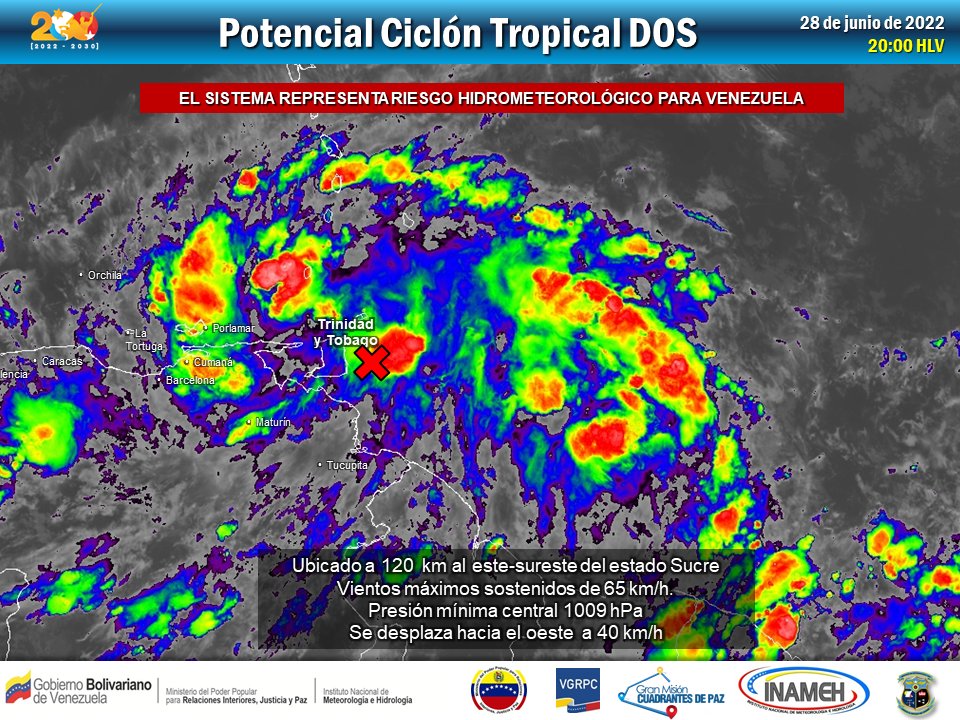
Satellite image of the advance of Tropical Cyclone 2 (Bonnie) towards the east coast of Venezuela. Photo: Twitter/@INAMEH.

Orinoco Tribune – News and opinion pieces about Venezuela and beyond
From Venezuela and made by Venezuelan Chavistas

Satellite image of the advance of Tropical Cyclone 2 (Bonnie) towards the east coast of Venezuela. Photo: Twitter/@INAMEH.
Caracas, June 28, 2022 (OrinocoTribune.com)—Starting at 1 p.m. on Tuesday, sailing in coastal areas will be prohibited off Venezuelan shores, due to the imminent arrival of a cyclone expected to affect nine states in the northern coastal area, including the Capital District.
This information was released by Venezuelan Vice President Delcy Rodríguez this Tuesday, June 28, who explained that flight restrictions will be put in place, and preventive measures will be taken on the roads of affected states. The cyclone is expected to touch land in Sucre state, in the east of Venezuela, at approximately 2:00 a.m. local time on Wednesday, June 29.
Despite being a South American country with extensive coastal areas facing the Caribbean sea, Venezuela in not a regular target for hurricanes or cyclones. The most recent incident affecting Venezuela, at least partially, was tropical storm Bret in 1993.
At that time, after the tumultuous second presidency of Carlos Andrés Pérez—impeached due to corruption charges—and under the temporary presidency of Ramón José Velásquez, at least 99 people were reported dead, more than 500 injured, and more than 5,000 displaced from their homes, mostly in the metropolitan area of Caracas and neighboring Aragua state.
#28Jun #INAMEHInforma Se observan núcleos convectivos asociados a lluvias o chubascos, algunos acompañados de actividad eléctrica en áreas del Zulia, Apure, Guárico, Anzoátegui, Monagas, Sucre, Delta Amacuro y Nueva Esparta; el resto del país con nubes fragmentadas. pic.twitter.com/5TL8uJ6Gou
— INAMEH (@INAMEH) June 28, 2022
RELATED CONTENT: Through the Month of May, Three Times More Tourists Than Last Year Arrived in Cuba
The trajectory of Tropical Cyclone Two, also known as Tropical Cyclone Bonnie, will be from east to west, with the probability of winds forming at up to 60 km/h and extended rains, explained the vice president. “The measures have been taken to mitigate the impact that this cyclone is going to have,” she said during a live broadcast on Venezolana de Televisión (VTV).
“As of one in the afternoon, sailing will be prohibited. Flight restrictions will also be applied and temporary closures will be taken on some routes, preemptively,” Rodríguez said during a press conference broadcast by state-owned VTV.
Faced with this situation, Rodríguez explained, heavy rains and sustained high-speed winds will occur in the country. “The population is asked to secure doors, windows and stay as far as possible in their homes,” she said.
Likewise, the governors and mayors of the affected states were urged to deploy services immediately in all vulnerable areas. “From this moment on, the governors and mayors must act to detect areas of vulnerability in which immediate actions must be taken,” Rodríguez said.
Classes suspended
In a televised address later the same night, President Nicolás Maduro expressed his belief that the meteorological event was exacerbated by climate change, and announced the cancellation of student classes at all levels across the entire country, on Wednesday and Thursday.
RELATED CONTENT: The Wide Role Brazil’s Military Has Played in the Destruction of the Amazon
#EnVivo 📹 | Videoconferencia para la evaluación de la llegada del Ciclón Tropical DOS a Venezuela. https://t.co/EqwZSVJpQ5
— Nicolás Maduro (@NicolasMaduro) June 29, 2022
Likewise, he said that the government has readied 70 tons of food, drinking water, and equipment to send to any region in need.
A summary of the decisions taken so far by the Venezuelan government in preparation for the imminent cyclone are:
• Classes suspended Wednesday June 29 and Thursday June 30.
• Flight restrictions.
• Prohibition of sailing and protection of ports and docks.
• Closure of roads that present any kind of risk.
• Closure of beaches.
• Activation of safe refuges in all regions.
• Education of the population before, during, and after the event.
• Activation of the organs of territorial defense (ODDI).
• Activation of food banks and special disaster equipment.
• State of alert at health care facilities in at-risk areas.
• Deployment of firefighters, civil protection workers, and the Venezuelan Army (FANB).
• Deployment of support machinery for emergency public works response.
• Activation of food and water reserves.
• Permanent monitoring.
• Activation of the Humanitarian Task Force.
Special by Orinoco Tribune staff
OT/JRE/SL